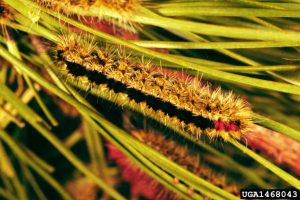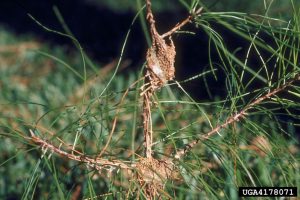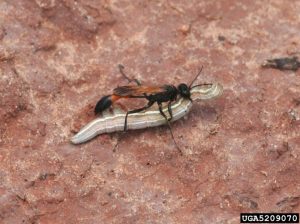Tent-Making Caterpillars
Quick Facts About Tent Caterpillars
- There are seven kinds of caterpillars that make a tent or silken shelter.
- Tent-making caterpillars attract a lot of attention due to the tents they make.
- Thier tents have an effect to cause early season defoliation.
- Tent Caterpillars are common in the spring and webworms are common in the fall.
Forest Tent Caterpillars
One of the most damaging and common tent caterpillar found in cities is the Forest Tent Caterpillar. The forest tent caterpillar does not establish a permanent tent as the other species. They produce silk on trees and use them as a rest area for the day. Forest tent caterpillars eat a number of plants including fruit trees and aspen.

William H. Hoffard, USDA Forest Service, Bugwood.org
Western Tent Caterpillar
Most often seen inside mountain-mahogany and aspen. The western tent caterpillar is one of the most common tent caterpillars and has been known to have killed areas of aspen trees. Its wingspan extends to about 28 millimeters.
The Fall Webworm
The fall webworm is one of the most common tent caterpillars during summer. It is found on plants such as cottonwood and chokecherry. In the winter the webworm is a pupa. Fall webworms cover large areas of a plant with loose silk and choose to feed within the tent. When they are full size, they will go out into the world and can cause a disturbance to some homes.

Linda Haugen, USDA Forest Service, Bugwood.org
Tiger Moth
The tiger moth’s caterpillars make a silk mat on pinyon, douglas-fir, white fir, lodgepole, and juniper. One of the only caterpillars to develop and feed during winter. They live in tents throughout early spring and by July they are adults and are flying.

USDA Forest Service – Ogden, USDA Forest Service, Bugwood.org
Other Tent-Producing Insects
Thee are a few other insects in Colorado that produce tents. Pine webworms can be found gathering foliage of ponderosa pine together. Uglynest caterpillars produce a nest of silk mixed with bits insect frass and leaves.

John Moser, USDA Forest Service, Bugwood.org
Control
The tent-making caterpillars have many natural enemies such as hunting wasps, birds, and predaceous bugs. Wasps and flies prey on caterpillars as well. Tent caterpillars are vulnerable to diseases as well. Because of these controls, any outbreaks of tent worms last usually no longer than a season. An exception to this is the fall webworm and the reason it has been spreading is due to the increased spraying of mosquitos.
Contact insecticides are effective for tent-making caterpillars as well. Sevin has been available for awhile. Insecticides such as cyfluthrin, permethrin, and esfenvalerate are effective for homeowner application and are very effective.

Whitney Cranshaw, Colorado State Universiy, Bugwood.org
